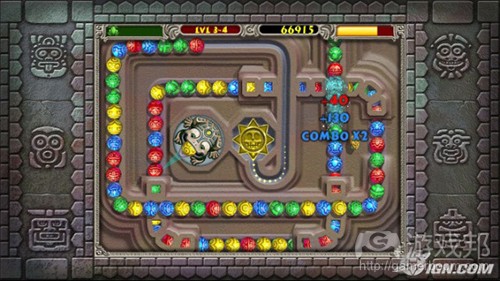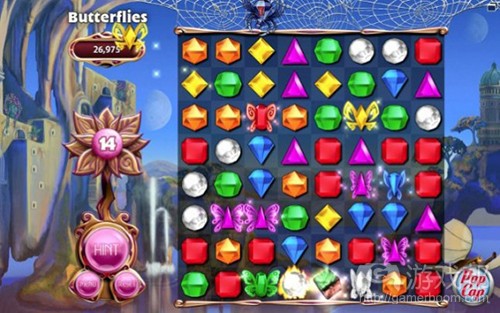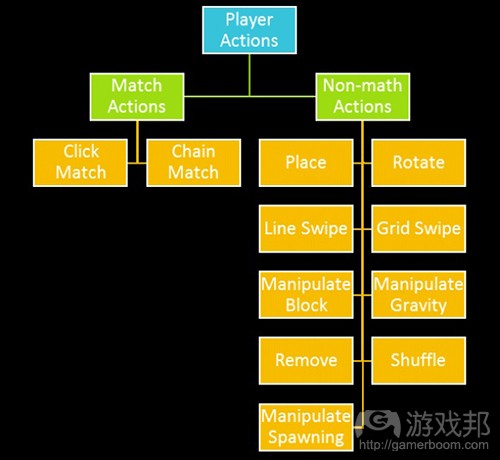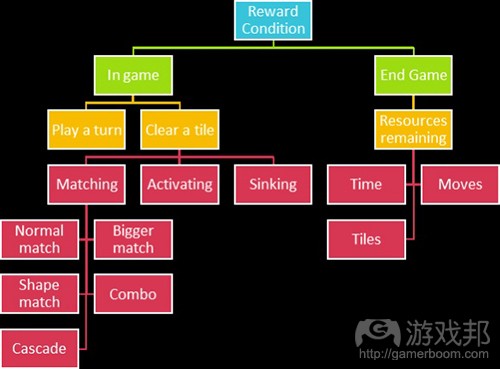分析匹配游戏类型及其机制
作者:Jonathan Bailey
数周前我和同事Herman Tulleken开始创造一个匹配游戏工具。我们试玩和分析了多款匹配游戏,并解析它们的机制。我们将在本文分享自己对此类游戏的调查发现,并将在之后推出一篇关于匹配游戏执行模式的文章。
我们在调查过程中发现许多游戏都具有与匹配游戏相似的特征。为此,我们决定排除那些本质上并不属于消除游戏的类型,以便简化我们的分析工作。
在此我们仅分析要求玩家在网格上玩游戏,采用2D形式,并且是单人模式的的匹配游戏。但下文有些理论也适用于一些3D游戏(例如Blockout)。
Jesper Juul在其论文《Swap Adjacent Gems to Make Sets of Three》中将消除贴图游戏定义为“玩家的目标是操作网格上的贴图以便配对的电子游戏”(我们在下文中对此类游戏进行了更为准确的定义)。
Juul称设计师所面临的挑战之一就是休闲玩家希望这类游戏可以立即上手。此类游戏不可以有过于复杂的学习曲线,必须让玩家觉得驾轻就熟。与此同时,游戏又要具有一定的独特性,这样才能从众多竞争者中脱颖而出。更重要的是,要有足够的独特性才能保证玩家留存率。这类游戏之间的区别通常很微妙,例如《宝石迷阵》就推出了一个有别于其前辈的永恒模式。
为此,匹配游戏的进化和发展远超过其他类型的游戏,并因此衍生了大量相似的游戏(通常被称为克隆游戏)。更重要的是比起其他游戏题材,我们更容易对匹配消除游戏进行分析。
定义
网格:网格是众多单元所构成的一个富有组织的系统。游戏通常使用常规的网格,如方形网格和六角形网格。
单元:单元即一个空白或是填满的容器。
贴砖:贴砖是可以用来填补单元的对象。单元只能容纳一个贴砖。除了转场动画状态中,贴砖总是只能位于一个单元中,或者完全处于网格之外。
阻块:彼此连接的贴砖群,可以视为一个整体单位。在许多游戏中,每个阻块只有一个贴砖。
配对贴砖游戏:玩家的目标是操纵网格中的阻块以便匹配贴砖。
配对:符合游戏配对规则的一组贴砖。最普遍的配对规则就是3个颜色相同并且相连的贴砖。配对可以包含多个贴砖,并且不可包含阻块中的所有贴砖。
颜色:用于区分贴砖的一个属性。这个属性通常是一种颜色,但也可以是一个形状,模式或数字。在这种情况下并非所有贴砖都有颜色。
重力:向特定方向移动所有贴砖的力量。
消除:贴砖从游戏中移出时就被消除了。
连线:对于方形网格来说,连线就是一个行或者列。对于多三角形和六角形网格来说,连线也有类似定义:以直线方式首尾相连的一个单元组。
连组:一个以上的配对。例如,交换两个贴砖得到了更多贴砖配对组(宝石迷阵)。
串连:连续配对。例如,玩家输入产生了一个自动配对,新生成或现成贴砖掉入空白单元形成了另一个自动配对(Bejeweled Twist)。另一个例子就是玩家输入满足一个配对条件,但自动配对的延迟允许玩家的额外输入,从而产生了更多个连续配对(Tetris Attack)。
游戏分类
我们将所有匹配消除游戏分为三个主类。这三个主要类型归纳了游戏循环和游戏目标的模式,并且影响了其余游戏的执行方式。
消除型游戏:匹配贴砖来消除(或者部分消除)那些没有自动填充贴砖的网格。这些网格可以是已经填满或者部分填满的状态(Chain Shot!)。
回避型游戏:匹配贴砖来避免网格被填满或者避免贴砖靠近网格边缘。网格刚开始时可能是空的或者部分填满的状态(Collapse!,Lines)。
耕作型游戏:在一直保持填满状态的网格上匹配贴砖。每次完成一个配对时就会消除贴砖,同时也会加入新贴砖,游戏目标是最大化或达到特定水准的参数(宝石迷阵)。
网格
网格布局
网格布局就是单元构造的方式,也就是单元彼此相联的方式。常用的网格包括方形(宝石迷阵, Around the World in 80 Days)网格以及六角形(Fractal,Same Hexagon)网格。特殊的例子是1D网格,它只有一行单元(祖玛)。
网格形状和大小
这类游戏运用的网格大小和形状多种多样,有可能是对称性或非对称性的。常用的网格大小和形状是8*8矩形(宝石迷阵3,Puzzle Quest: Challenge of the Warlords)。网格大小可能在游戏过程中发生变化(Uo Poko, Puzzle Bobble, Tetris Plus 2)。
阻块结构
这里有4种不同的阻块结构。以下列表中除了第一种,其余都属于多贴砖阻块。
单个贴砖:只有一个贴砖的阻块(宝石迷阵)
全色盲型:采用同类贴砖的不同形状阻块(俄罗斯方块)
单一型态:使用不同类贴砖的同一形状阻块(Columns)
混合型:使用不同类贴砖的不同形状阻块(Groovin’Blocks)
贴砖设置结构
贴砖设置属性
我们将贴砖属性划分为三类:
清除类型:确定贴砖是否以及如何被清除。
重力属性:确定贴砖是否以及何时受到重力影响。
游戏操作:贴砖被清除时发生的情况。
这种分类从设计角度来看似乎有违常理,但却很便于执行。
清除类型
所有贴砖都有一个清除属性。以下图表显示了不同清除属性之间的相互关系。
彩色贴砖:使用与颜色相关的匹配规则就可以进行配对的贴砖。
通配贴砖:使用与颜色相关的匹配规则就可以进行配对的贴砖,但它可以替换成任何颜色。
下沉贴砖:可以将其置于网格底部进行消除。
激活贴砖:可以点击进行消除的贴砖。
非清除贴砖:无法清除的贴砖。
重力
*影响
下坠:受重力影响
飘浮:不受重力影响
*方向
游戏操作
在清除贴砖时可能发生任何数量的游戏操作行为。这些操作包括:
*生成一个贴砖
*给予奖励(查看下文的奖励类型)
*游戏结束
例子:
*《宝石迷阵》中的彩色配对贴砖在没有游戏操作行为的情况下,就会变成下坠的彩色贴砖。
*《Candy Crush Saga》中的阻块贴砖如果没有游戏操作行为,就是一个飘浮的通配贴砖。
*《宝石迷阵3》中的超立方体贴砖就是一个坠落的下沉贴砖,它被消除时游戏就会结束。
*《Triple Town》中的箱子贴砖是一个飘浮的激活贴砖,被消除时会给予玩家奖励。
*《Threes》中的数字贴砖是飘浮的彩色贴砖,被消除时会产生新贴砖。
贴砖设置的额外结构
序列:彩色贴砖以一个序列方式进行组合,用于玩法或积分(Triple Town,Threes,Gems with Friends)。
多轴线:除了颜色和模式,游戏中还有多种匹配属性。配对可以发生于拥有相同颜色,但不同模式的贴砖,也可以发生于具有相同模式而颜色不同的贴砖(Passage 4 XL)。
阻块生成
在这部分内容中,对于无法找到对应例子但我们相信它必然存在的情况,我们就用 (*)来标注。如果你知道相应的例子,请与我们一起分享。
生成算法
阻块的选择方式:
*随机性(俄罗斯方块)
*采用预定的顺序(*)
*为了动态改变游戏难度(Candy Crush Saga)
*来自最近消除的单元(*)
*来自随机出现的固定批量(Threes)
*来自游戏中剩余的贴砖(Puzzle Bobbie)
阻块生成的地方
阻块生成于:
*网格边缘
来自被消除单元的列(宝石迷阵)
来自中心单元(俄罗斯方块,Puyo Puyo)
来自随机单元(Meteos)
按顺序生成,例如总是从左到右(Tidalis)
来自任何单元(Tetris Attack,Collapse!)
*来自阻块被消除的单元(*)
*来自空白单元(Lines)
阻块生成的数量
生成的阻块可以是:
*固定的数量(Lines)
*足够填充所有空白单元(宝石迷阵)
*足够以最小高度保持一个列(Tidalis)
阻块何时生成
在以下情况会添加阻块:
*完成一个配对时(宝石迷阵)
*未形成一个配对时(Lines)
*完成一个串连时(Tetris Attack)
*每个回合之后(Ultimate-4)
*数个回合之后(*)
*玩家添加阻块之时(Stickets)
玩家操作
这是玩家改变游戏状态的方法。
点击配对
玩家点击配对贴砖组中的任意贴砖就可以消除这组贴砖(Collapse!,Same Hexagon)
连锁配对
玩家点击或者拖拽一个配对贴砖组中的每个贴砖就可以消除这些贴砖(Azkend,Jelly Splash,4 Elements)。
位置
玩家在网格中布置一个阻位。
*玩家可能无法选择下一步要放置哪个阻块(Columns),也可能可以从一系列阻块中做出选择(Stickets)。
*可以向任何空白的单元组放置相同形状的阻块(Lines,Stickets),或者向具有限制性的空白单元组放置相同形状的阻块(Might & Magic: Clash of Heroes, Columns)。
旋转
玩家通过点击或拖拽,旋转两个或多个单元的贴砖。这一操作的最常用方法就是切换——旋转2个单元(宝石迷阵3)。其他例子包括在三四个单元中旋转贴砖(Hexic,Bejeweled Twist)。
连线滑动
玩家向一个方向动连成一线的贴砖。这条线被包围起来,这样处于网格一头之外的贴砖就会从相反方向重新进入网格。
网格滑动
玩家滑动整个网格,所有单元都会移动到可行的空间,或者组成一个配对。
操纵阻块
阻块操纵是由以下两种情况定义:
*玩家如何操纵阻块:例如旋转阻块(俄罗斯方块)或在阻块内部更改贴砖位置(Columns)
*玩家何时操纵阻块:在放置之前(俄罗斯方块)或者放置之后(Chain Shot)。
操纵重力
重力变化包括以下两种情况:
*玩家打开或关闭这一功能(Gravity Swith Puzzle Match)
*玩家通过旋转网格,更改与网格相关的重力方向(Vizati,Spinzizzle)
移除
玩家点击贴砖进行消除。
洗牌
玩家向不同的随机单元移动一些或所有贴砖(Candy Crush Saga)。
操纵生成
玩家增加或减少某个阻块的生成机率(Meteos,Tetris Attack,Tidalis)。
自动操作
这是游戏状态自动变化的方式。
阻块生成
这个自动操作会向游戏添加新贴砖。我们已经在前文中讨论过阻块生成的不同层面。
自动匹配
在匹配并非玩家操作行为的游戏中,玩家每次输入都会产生自动匹配的结果。如果玩家输入产生了一个匹配贴砖组合,自动匹配就会从网格中消除贴砖。
自动匹配也会以串联形式,在没有玩家输入的情况下发生。
重力
重力会影响进入网格的阻块生成,或者导致贴砖进入已经消除贴砖的空白单元。重力可以发生在任何方向,包括边缘方向或网格中心。
重力方向也可能根据所消除的贴砖在游戏过程中发生变化(Super Collapse!)或者根据贴砖消除方式进行变化,例如发生连锁匹配的方向(Puzzle Quest: Galactrix)。
排斥
放入一个阻块推开所有相邻的贴砖。被推开的贴砖形成一个连组,该条线上的所有贴砖就会将一个单元移开(Fractal)。空白单元可能会打破这个连组,也可能无法打破。
引力
被消除的贴砖被相领单元中的贴砖所代替(Trigon)。
匹配条件
创造一个配对所需的贴砖数量
创造一个配对所需的最普遍贴砖数量就是3(宝石迷阵),但也有一些游戏不使用3作为配对的最小需求数量,而是选择2(Threes)、4(Lumines, Gem Huntz)、7(Fractal)或者10(俄罗斯方块)等数量。
创造配对所需的方向和贴砖形状
常用形状包括:
*水平或重直线
*L形
*T形
*十字形
*方形
*三角形
*六角形
特殊案例
也有一些较不常用的配对规则,例如:
*匹配贴砖可能被没有填充匹配贴砖的单元所分开
分离单元必须是空白的,匹配贴砖必须位于同一轴线(Totemo,Color Tiles)
分离单元可以用非匹配贴砖填充,并且匹配贴砖不必处于同一轴线(Tidalis)
*匹配贴砖来创造一个闭合形状,并用它消除这些贴砖,以及闭合形状中的所有单元内的贴砖(Quarth)
*根据每个贴砖的属性,以任意形状匹配贴砖(Tidalis)。
奖励
奖励类型
奖励类型的例子包括:
*积分
*特殊贴砖
*特殊操作
特殊贴砖或特殊操作的结果可以相互变换。这方面的例子包括:
*额外时间
*重置时间
*额外行动
*消除连线
*消除相邻贴砖
*消除所有特定颜色的贴砖
奖励条件
可以根据一个或多个条件组合进行奖励。
游戏结束条件
游拥有一个或多个结束条件。这些可分为失败条件或胜利条件(通常它们也可能相互转变)。以下是一些典型例子:
胜利条件
玩家在以下情况会获胜:
*网格被消除(Puzznic)
*玩家完成特定数量的配对或者达到一定的积分(宝石迷阵)
*玩家完成特定数量的配组
*玩家消除了特定的贴砖(Azkend)
失败条件
玩家会在以下情况失败:
*网格已满(Stickets)
*贴砖达到网格边缘(俄罗斯方块,Collapse!)
*玩家用光所有资源(Fractal)
*玩家没法再移动(Threes)
(本文由游戏邦编译,转载请注明来源,或咨询微信zhengjintiao)
Match Game Mechanics: An Exhaustive Survey
- Jonathan Bailey
At Gamelogic we are obsessed with game rules.
Several weeks ago my colleague Herman Tulleken and I began building a match game tool. We played and analyzed many match games to deconstruct their mechanics. In this article we share our findings as part of a larger research and development project, which will later include an article on match game implementation patterns.
During our research we found many games with similar features to match games. By changing how we define a match rule it is possible to include a wider variety of games for which our scheme can be applied. However, we decided against including match rules that are not intuitively associated with match games to keep our task manageable. How far our definitions can be stretched is something we want to explore in the future.
For this document, we only include match games that are played on a grid, are 2D, and are on a single layer. Some 3D games (for instance Blockout) easily fall into our scheme if certain concepts are adapted for 3D.
In his paper Swap Adjacent Gems to Make Sets of Three, Jesper Juul defines matching tile games as”video games where the object of the player is to manipulate tiles on a grid in order to create matches”(We give a more precise definition below to suit our terminology and structure we use here.)
Juul says that one of the challenges that designers face is that casual gamers want to pick up and play these games immediately. There must be a level of familiarity without a steep learning curve. At the same time, games need to have enough uniqueness to stand out from the competition, and more importantly, enough to keep the player playing their game. Often these differences are subtle, such as Bejeweledintroducing a timeless mode to its predecessors.
Because of this, the evolution of match games has occurred more incrementally than some other types of games, and it has resulted in many similar games (often labeled clones). More importantly for us, it makes match games easier to analyze than many other game genres.
Definitions
Grid: A grid is a structured arrangement of cells. Games often use regular grids such as square grids and hexagonal grids.
Cell: A cell is a container that can be empty or full.
Tile: A tile is an object that can fill a cell. Cells cannot contain more than one tile. Except for during state transition animations, tiles are always inside exactly one cell, or completely outside the grid.
Block: A connected group of tiles that is manipulated as a unit. In many games blocks have only one tile each.
Matching tile game: a game where the object of the player is to manipulate blocks on a grid in order to create matches between tiles.
Match: Is a group of tiles that satisfy the game’s matching rules. The most common match rule is three connected tiles with the same color. Matches can contain tiles from more than one block, and matches need not contain all the tiles of a block.
Color: A property to distinguish tiles. This property is often an actual color, but can also be a shape, pattern or number. Not all tiles have a color in this sense.
Gravity: A force that moves all tiles in a certain direction.
Clear: A tile is cleared when it is removed from the game.
Line: For square grids, a line is a row or column. For triangular and hexagonal grids, a line is similarly defined: a group of cells from end to end in a straight line.
Combo: More than one simultaneous match. For example, if two tiles are swapped and this results in both tiles matching with other tiles (Bejeweled).
Cascades: Consecutive matches. For example, a player’s input results in an auto match, and the new or existing tiles fall into empty cells in such a way that another auto match occurs (Bejeweled Twist). Another example is a player’s input fulfils a match condition, but a delay in the auto match allows further input/s from the player which may result in multiple consecutive matches (Tetris Attack).
Game classification
We classify all match games into three main categories. These main groups capture the patterns in game loops and game goals, and affects the implementation of the rest of the game.
Elimination game: Tiles are matched to clear (or partly clear) a grid that doesn’t refill as the player plays. The grid can begin full or partly full (Chain Shot!).
Avoidance game: Tiles are matched to prevent a grid from becoming full or from tiles reaching an edge of the grid. The grid can begin empty or a partly full (Collapse!, Lines).
Farming game: Tiles are matched on a grid that stays full. Every time a match is made and tiles are cleared, new tiles are added, and the goal is to maximize or reach a certain level of a metric (Bejeweled).
Grid
Grid topology
A grid’s topology is how the cells are structured – which cells are connected. Commonly used grids include square (Bejeweled, Around the World in 80 Days), and hexagonal (Fractal, Same Hexagon) grids. A special case is 1D grids, which is a single line of cells, possibly curved (Zuma).
(Fractal)
(Zuma Deluxe)
Grid shape and size
A large variety of sizes and shapes are used, both symmetrical and unsymmetrical. A commonly used size and shape for a grid in a match game is an 8×8 rectangle (Bejeweled 3, Puzzle Quest: Challenge of the Warlords). Grid sizes can change during a game (Uo Poko, Puzzle Bobble, Tetris Plus 2).
(Bejeweled 3)
(Gameplay sample: Buggle)
Block structure
There are four different block structures. All but the first in this list are multi-tile blocks.
Single-tile: Blocks with a single tile (Bejeweled)
Monochromatic: Tiles of the same type in different shaped blocks (Tetris).
Monomorphic: Same shaped blocks using tiles of different types (Columns).
Mixed: Different shaped blocks using tiles of different types (Groovin’ Blocks).
Tile set structure
Tile set properties
We classify tile properties into three categories:
Clearing type: defines whether and how tiles are cleared.
Gravity properties: properties that define whether and how tiles are affected by gravity.
Game action: something that happens when the tile is cleared.
This classification may seem unintuitive from a design perspective, but it is useful for implementation.
Clearing Type
All tiles have a single clearing property. The chart below shows how the different clearing properties relate to each other.
Color tile: A tile that can be matched using matching rules that involve colors.
Wildcard: A tile that can be matched using matching rules that involve colors, except it can substitute any color.
Sinker: A tile that can be cleared by getting it to the bottom of the grid.
Activator: A tile that can be cleared by clicking on it.
Non-clearing tile: A tile that cannot be cleared.
Gravity
Influence:
Falling: affected by gravity
Floating: not affected by gravity
Direction
Game action
Clearing tiles can have any number of game actions that are performed when the tiles are cleared. These actions include:
Generates a tile
Gives a reward (see Reward Types)
Ends the game
Examples
The colored matching tiles in Bejeweled are falling color tiles with no game actions.
The Icing (Meringues) blocker tile in Candy Crush Saga is a floating wildcard with no game actions.
The hypercube tile in Bejeweled 3 is a falling wildcard that gives a reward when cleared.
The talisman tile in Azkend is a falling sinker that ends the game when cleared.
The chest tile in Triple Town is a floating activating tile that gives a reward when cleared.
The number tiles in Threes are floating colored tiles that generate new tiles when cleared.
Tile set additional structure
Sequence: Color tiles arranged in a sequence that is exploited for gameplay or scoring (Triple Town, Threes, Gems with Friends).
Multi-axis: There is more than one match property for example color and pattern. Matches can occur with tiles of the same color regardless of the pattern or matches can occur with tiles that have the same pattern regardless of the color (Passage 4 XL).
Block Spawning
This section contains a few items marked with (*) for which we couldn’t find an example but for which we are sure one must exist. If you know of any examples, please share them in the comments.
Spawning algorithms
Blocks are selected
randomly (Tetris)
in a predefined order (*)
so as to change the difficulty dynamically (Candy Crush Saga)
from recently cleared cells (*)
from a fixed batch with a random order (Threes)
from remaining tiles in the game (Puzzle Bobble)
Where blocks are spawned
Blocks are spawned
at the edge of the grid
from the column of a cleared cell (Bejeweled)
from the center cell (Tetris, Puyo Puyo)
from a random cell (Meteos)
ordered, such as always left-to-right (Tidalis)
from every cell (Tetris Attack, Collapse!)
in cells where blocks have been cleared (*)
in an empty cell (Lines)
Number of blocks spawned
The number of cells to spawn can be
a fixed number (Lines)
enough to fill all empty cells (Bejeweled)
enough blocks to keep a column at a minimum height (Tidalis)
When blocks are spawned
Blocks are added
after time (Collapse!)
when a match is made (Bejeweled)
when a match is not made (Lines)
after a cascade is completed (Tetris Attack)
after every turn (Ultimate-4)
after a number of turns (*)
when the player adds blocks (Stickets)
Player actions
This is all the ways the player can change the game state.
Click Match
The player clicks on any tile in a matching group of tiles to clear those tiles (Collapse!, Same Hexagon).
Chain Match
The player clicks on each tile or drags over each tile in a matching group of tiles to clear those tiles. (Azkend, Jelly Splash, 4 Elements)
Place
The player places a new block on the grid.
There can either be no choice of which block to place next (Columns), or there can be a choice between a number of available blocks to place next (Stickets).
The block can be placed on either any empty group of cells with the same shape (Lines, Stickets), or on any of a restricted group of empty cells with the same shape (Might & Magic: Clash of Heroes, Columns).
Rotate
The player rotates tiles of two or more cells, usually by clicking or dragging over the cells. The most common use of this action is swapping – rotating two cells (Bejeweled 3). Other examples include rotating the tiles in three cells (Hexic) or four cells (Bejeweled Twist).
Line Swipe
The player moves a whole line of tiles in the direction of the line. Lines are wrapped, so that tiles that go out the one end of the grid re-enters the grid on the opposite side (Chuzzle, Metronous).
Grid Swipe
The player swipes the whole grid, and all cells move as long as there is space available, or a match can be formed (Threes).
Manipulate Block
Block manipulation is defined by:
how the block is manipulated: for example rotating the block (Tetris) or changing the position of tiles within a block (Columns), and
when the block is manipulated: before placement (Tetris) or after placement (Chain Shot).
(Gameplay sample: Columns)
Manipulate Gravity
Changes in gravity include:
The player turns it on or off (Gravity Switch Puzzle Match)
The player changes the direction of gravity relative to the grid, possibly by rotating the grid (Vizati,Spinzizzle).
(Gameplay sample: Spinzizzle)
Remove
The player clicks on a tile to clear it.
Shuffle
The player moves some or all tiles into different randomly selected cells (Candy Crush Saga).
Manipulate spawning
The player increases or decreases the rate at which blocks are spawned (Meteos, Tetris Attack, Tidalis).
Automatic Actions
These are all the ways the game state changes automatically.
Block spawning
This automatic action adds new tiles to the game. We have already discussed various aspects of block spawning in a previous section.
Auto-match
In games where matching is not a player action, auto-match occurs as result of every player input. If the player input results in a group of matched tiles, auto-match will clear the tiles from the grid.
Auto-match can also occur without player input as a cascade.
Gravity
Gravity can influence generated blocks which enter the grid or cause tiles to move into empty cells created from clearing tiles. Gravity can be in any dirction, including toward an edge (Bejeweled) or toward the centre of the grid (Fortex Zen).
The direction of gravity can change during the game depending on which tiles are cleared (Super Collapse!) or depending on how they are cleared, for example the direction in which a chain match occurs (Puzzle Quest: Galactrix).
Repulsion
Placing a block pushes all neighboring tiles away from it. The pushed tile create a chain whereby all tiles in that line move one cell away from its previous position (Fractal). Empty cells may or may not break this chain.
Attraction
Cleared tiles are replaced by tiles in neighboring cells (Trigon).
Matching conditions
Number of tiles needed to make a match
The most common number of tiles needed to make a match is 3 (Bejeweled); however, there are games that do not use three tiles as the minimum requirement for a match. Here are some examples:
2 (Threes)
4 (Lumines, Gem Huntz)
7 (Fractal)
10 (Tetris)
Orientation and shape of tiles needed to make a match
Common shapes include:
Horizontal or vertical lines
L-shape
T-shape
Cross
Square
Triangle
Hexagon
Special cases
There are other less common rules for matching. Here are some examples:
Matching tiles can be separated by cells that are not filled with matching tiles.
Sepearating cells must be empty and matching tiles must be on the same axis (Totemo, Color Tiles).
Separating cells can be filled with non matching tiles and matching tiles do not have to be on the same axis (Tidalis)
Match tiles to create a closed shape, which clears those tiles and all of the tiles within the cells of that closed shape (Quarth).
Match tiles in an aribitory shape, accoridng to the properties of each tile (Tidalis).
Matching
Rewards
Reward types
Examples of reward types include:
Score
Special tiles
Special actions
The outcome of a special tile or special action are interchangeable. Examples include
Extra time
Time reset
Extra moves
Clear lines
Clear neighbors
Clear all tiles of a particular color
Reward conditions
Rewards can occur due to a single condition or as a combination of conditions.
Game-end conditions
Games have one or more conditions for ending the game. These are are classified as lose conditions or win conditions (although they are often interchangeable). Below are typical ones.
Win conditions
The player wins the game when
the grid is clear (Puzznic)
the player makes a specified number of matches or reaches a specified score (Bejeweled)
the player makes a specified set of matches (Jewel Fever)
the player clears a specific tile (Azkend)
Lose conditions
The player loses the game when
the grid is full (Stickets)
a tile reaches an edge of the grid (Tetris, Collapse!)
the player runs out of resources (Fractal)
the player has no more possible moves (Threes)(source:gamecareerguide)
下一篇:影响团队发挥生产力的2大问题















































